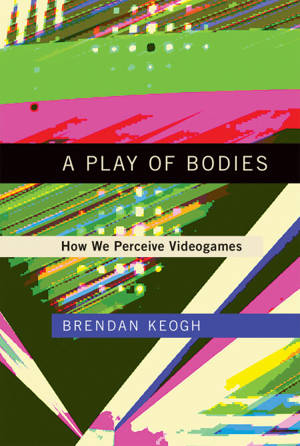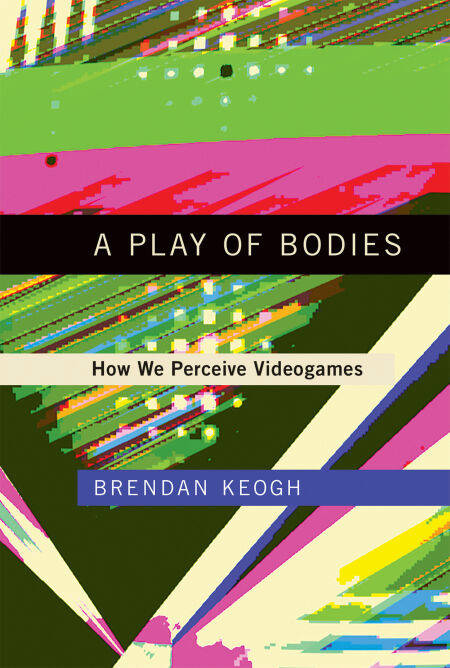
Je cadeautjes zeker op tijd in huis hebben voor de feestdagen? Kom langs in onze winkels en vind het perfecte geschenk!
- Afhalen na 1 uur in een winkel met voorraad
- Gratis thuislevering in België vanaf € 30
- Ruim aanbod met 7 miljoen producten
Je cadeautjes zeker op tijd in huis hebben voor de feestdagen? Kom langs in onze winkels en vind het perfecte geschenk!
- Afhalen na 1 uur in een winkel met voorraad
- Gratis thuislevering in België vanaf € 30
- Ruim aanbod met 7 miljoen producten
Zoeken
€ 34,49
+ 34 punten
Uitvoering
Omschrijving
An investigation of the embodied engagement between the playing body and the videogame: how player and game incorporate each other.
Our bodies engage with videogames in complex and fascinating ways. Through an entanglement of eyes-on-screens, ears-at-speakers, and muscles-against-interfaces, we experience games with our senses. But, as Brendan Keogh argues in A Play of Bodies, this corporal engagement goes both ways; as we touch the videogame, it touches back, augmenting the very senses with which we perceive. Keogh investigates this merging of actual and virtual bodies and worlds, asking how our embodied sense of perception constitutes, and becomes constituted by, the phenomenon of videogame play. In short, how do we perceive videogames?
Keogh works toward formulating a phenomenology of videogame experience, focusing on what happens in the embodied engagement between the playing body and the videogame, and anchoring his analysis in an eclectic series of games that range from mainstream to niche titles. Considering smartphone videogames, he proposes a notion of co-attentiveness to understand how players can feel present in a virtual world without forgetting that they are touching a screen in the actual world. He discusses the somatic basis of videogame play, whether games involve vigorous physical movement or quietly sitting on a couch with a controller; the sometimes overlooked visual and audible pleasures of videogame experience; and modes of temporality represented by character death, failure, and repetition. Finally, he considers two metaphorical characters: the “hacker,” representing the hegemonic, masculine gamers concerned with control and configuration; and the “cyborg,” less concerned with control than with embodiment and incorporation.
Our bodies engage with videogames in complex and fascinating ways. Through an entanglement of eyes-on-screens, ears-at-speakers, and muscles-against-interfaces, we experience games with our senses. But, as Brendan Keogh argues in A Play of Bodies, this corporal engagement goes both ways; as we touch the videogame, it touches back, augmenting the very senses with which we perceive. Keogh investigates this merging of actual and virtual bodies and worlds, asking how our embodied sense of perception constitutes, and becomes constituted by, the phenomenon of videogame play. In short, how do we perceive videogames?
Keogh works toward formulating a phenomenology of videogame experience, focusing on what happens in the embodied engagement between the playing body and the videogame, and anchoring his analysis in an eclectic series of games that range from mainstream to niche titles. Considering smartphone videogames, he proposes a notion of co-attentiveness to understand how players can feel present in a virtual world without forgetting that they are touching a screen in the actual world. He discusses the somatic basis of videogame play, whether games involve vigorous physical movement or quietly sitting on a couch with a controller; the sometimes overlooked visual and audible pleasures of videogame experience; and modes of temporality represented by character death, failure, and repetition. Finally, he considers two metaphorical characters: the “hacker,” representing the hegemonic, masculine gamers concerned with control and configuration; and the “cyborg,” less concerned with control than with embodiment and incorporation.
Specificaties
Betrokkenen
- Auteur(s):
- Uitgeverij:
Inhoud
- Aantal bladzijden:
- 248
- Taal:
- Engels
Eigenschappen
- Productcode (EAN):
- 9780262345446
- Verschijningsdatum:
- 5/04/2018
- Uitvoering:
- E-book
- Beveiligd met:
- Adobe DRM
- Formaat:
- ePub

Alleen bij Standaard Boekhandel
+ 34 punten op je klantenkaart van Standaard Boekhandel
Beoordelingen
We publiceren alleen reviews die voldoen aan de voorwaarden voor reviews. Bekijk onze voorwaarden voor reviews.









